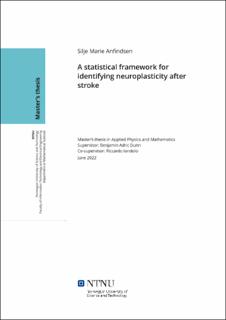| dc.contributor.advisor | Dunn, Benjamin Adric | |
| dc.contributor.advisor | Iandolo, Riccardo | |
| dc.contributor.author | Anfindsen, Silje Marie | |
| dc.date.accessioned | 2022-11-08T18:19:34Z | |
| dc.date.available | 2022-11-08T18:19:34Z | |
| dc.date.issued | 2022 | |
| dc.identifier | no.ntnu:inspera:104646180:35884069 | |
| dc.identifier.uri | https://hdl.handle.net/11250/3030761 | |
| dc.description.abstract | Hjernen er et fascinerende organ – milliarder av elektriske signaler mellom nevroner transporterer kontinuerlig informasjon. Ved å bruke funksjonell magnetresonansavbildning, også kalt fMRI, kan vi modellere disse prosessene. Vi tar for oss et nettverk av noder og kanter som reflekterer grupper av nevroner og deres funksjonelle forbindelser. Kantene beregnes ved å bruke en statistisk avhengighet av fMRI-signaler innenfor hver node, kjent som funksjonell konnektivet. Under et hjerneslag kan deler av hjernen bli skadet. Nevroplastisitet, hjernens evne til å reorganiseres, er antatt å oppstå i etterkant av et slag. Reorganisering betyr at nye forbindelser kan dannes, og eksisterende forsterkes. I denne masteroppgaven undersøker vi om det er mulig å observere denne reorganiseringen ved bruk av fMRI. En forståelse av denne prosessen kan bidra til å forbedre gjenoppretting av tapt motorisk funksjon etter hjerneslag. Vi undersøkte tre fMRI skanninger utført over tre måneder på friske eldre deltakere i hvilende tilstand. Vi har opprettet et statistisk rammeverk for å være sikker på at observerte endringer i funksjonell konnektivet etter slag representerer reorganisering. Rammeverket evaluerer påliteligheten til ulike modeller av det nevrale nettverket og predikerer hvor mange pasienter som bør rekrutteres til et studie på St.Olav Hospital for å oppdage reorganisering. Videre kan rammeverket inkludere nye metoder og datakvalitet, og eksisterer så vidt kjent ikke i dag. Resultatene viser at de estimerte nettverkene ikke er i stand til å produsere pålitelige prediksjoner av antall nødvendige slagpasienter. Dette er på grunn av fMRI støy, brudd på modellantagelser og et begrenset antall deltakere i studiet. Imidlertid indikerer de estimerte utvalgsstørrelsene at studiet sannsynligvis ikke vil være i stand til å rekruttere nok slagpasienter. | |
| dc.description.abstract | The brain is a fascinating organ—billions of electric signals between neurons transport information continuously. Using functional magnetic resonance imaging (fMRI), we can approximate these processes. We consider a network of nodes and edges reflecting groups of neurons and their functional connections, respectively. The nodes are defined according to a partition of the human brain, referred to as a brain parcellation. The edges are computed using a statistical dependence of fMRI signals from the nodes, known as functional connectivity (FC). During a stroke, parts of the brain network become damaged. Neuroplasticity, or the brain's ability to rewire itself, is presumed to occur after a stroke. Rewiring entails the formation of new connections or the reinforcement of existing ones. This thesis investigates whether we can detect rewiring using fMRI. An understanding of this process can contribute better to facilitating the restoration of lost motor function after stroke. We examined three fMRI scans performed over three months on healthy elderly participants in resting state. We have established a statistical framework to ensure that observed changes in FC after stroke are associated with recovery.
The framework includes a Test-Retest reliability evaluation of a variety of brain parcellations and FC methods and a prediction of how many patients should be recruited for a stroke rehabilitation study at St.Olav Hospital to identify FC changes after stroke. As far as we know, the framework, which can readily incorporate new methodologies and data quality, does not exist. Results reveal that the estimated brain networks cannot provide a reliable conclusion on the number of required stroke patients. This is due to fMRI noise, violation of model assumptions, and a limited number of control subjects. Nevertheless, the estimated sample sizes indicate that the stroke rehabilitation study will most likely be unable to enrol enough stroke patients. | |
| dc.language | eng | |
| dc.publisher | NTNU | |
| dc.title | A statistical framework for identifying neuroplasticity after stroke | |
| dc.type | Master thesis | |
